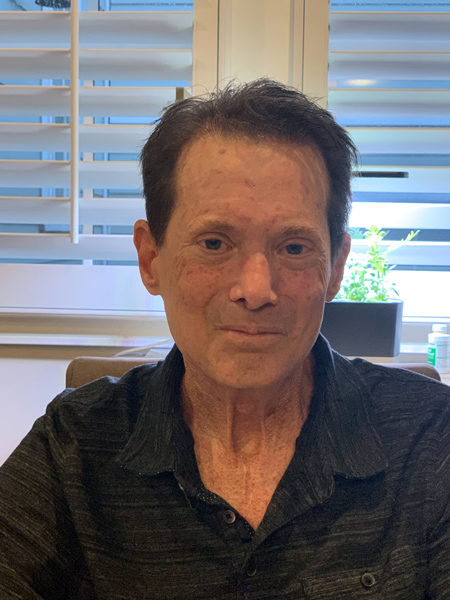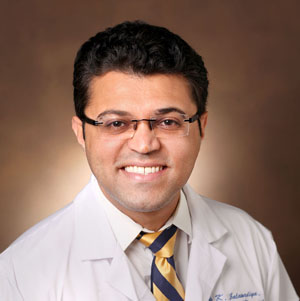by Matt Batcheldor
Evan Busman was sitting in his townhome in Marietta, Georgia, with advanced heart failure, getting seriously winded every time he had to get up to walk to his mailbox.

He had visited several hospitals around the country, trying to find the best place to treat his heart until he could be considered a candidate for a heart transplant. His condition was worsening as doctors tried to find the right medication regimen to maintain his quality of life.
“I was thinking how many years I had left, and if I could get to a transplant,” Busman said.
Busman’s research led him last year to Vanderbilt Heart and Vascular Institute (VHVI), where, as part of his medical management, he was implanted with the CardioMEMS HF System by Sandip Zalawadiya, MBBS, assistant professor of Medicine and the lead physician for the CardioMEMS program at VHVI. The paper clip- sized device remotely monitors the pressure in his pulmonary artery, alerting the medical professionals at Vanderbilt about subtle fluid retention changes in his body. The device serves as a kind of early-warning system, allowing doctors to adjust medications in response to data before symptoms of fluid congestion occur that may require hospitalization.
“Evan’s heart failure was in advanced stages, and he had many medical problems that needed to be addressed prior to being considered for heart transplantation,” Zalawadiya said.
“While our focus was to buy him more time to overcome those medical problems, it was of paramount importance that we keep him stable, out of the hospital and with the best quality of life he could have.”

VHVI recently celebrated a milestone of implanting 50 CardioMEMS devices, Zalawadiya said. “It’s a tremendous resource for many patients, especially when it helps to keep them out of the hospital, and helps improve their quality of life,” he said. “And the beauty of this device is it tells you many days in advance that you will have symptoms of heart failure. It’s almost like you can see into the future and tell patients that, ‘I know you’re not feeling anything right now, but let’s go ahead and make some adjustments now so that you never feel those symptoms.’”
Heart failure hospitalizations decreased by 33% in patients using the device in its original clinical trial. Additionally, an August 2020 study of 1,200 patients implanted with the device in real-world practice led by Vanderbilt faculty showed a 57% decrease in heart failure hospitalizations and 27% reduction in all-cause hospitalizations.
In addition, a study just published in The Lancet and presented at the European Society of Cardiology suggested that the use of the CardioMEMS device reduces heart failure hospitalizations for people with milder heart failure, noted the article’s lead author and one of the world’s leading experts in the technology, JoAnn Lindenfeld, MD, professor of Medicine.
The implantation of the device takes place during a right heart catheterization, a common procedure that most heart failure patients have already experienced. Implanting the device is quick and painless and is performed in about 30 minutes by Zalawadiya. Patients are asked to take just one day off work and go home the same day.
Once implanted, patients lie for a couple of minutes on a special pillow that transmits their medical data to Vanderbilt.
Busman said it allowed his doctors to adjust his medications, in real time, which offered a path toward getting stronger by keeping potential excess fluid retention at bay. Ultimately, Vanderbilt accepted him as a transplant patient, and he received a new heart. The CardioMEMS device has been so useful, it was left in place after transplant, Busman said.
“It’s still keeping me in optimal condition,” he said. “I feel really good, the best I’ve felt in years. The transplant has been, to this date, very successful. They’re really happy with it — the transplant team. I’m really happy with it. It’s going really well.”
Zalawadiya said having the device reassures patients that their condition is being closely monitored.
“It’s an excellent virtual monitoring device for the patients,” he said. “To some extent, it does give us peace of mind that our patients are doing as well as possible.”
New analysis of one of the trials led at Vanderbilt has shown that patients in this monitored management describe less burden of their disease and a greater sense of control over their heart failure, said Lynne Stevenson, MD, Lisa M. Jacobson Professor of Cardiovascular Medicine and another one of the world’s leading experts in the technology.
“I’ve never seen care given like the team at Vanderbilt,” Busman said. “They’re just amazing.”
“Several skilled and dedicated health professionals have made this program a success at Vanderbilt,” Zalawadiya said. “To large extent, the credit goes to our highly skilled and dedicated nurse practitioners and nurses that manage heart failure and transplant patients.”












